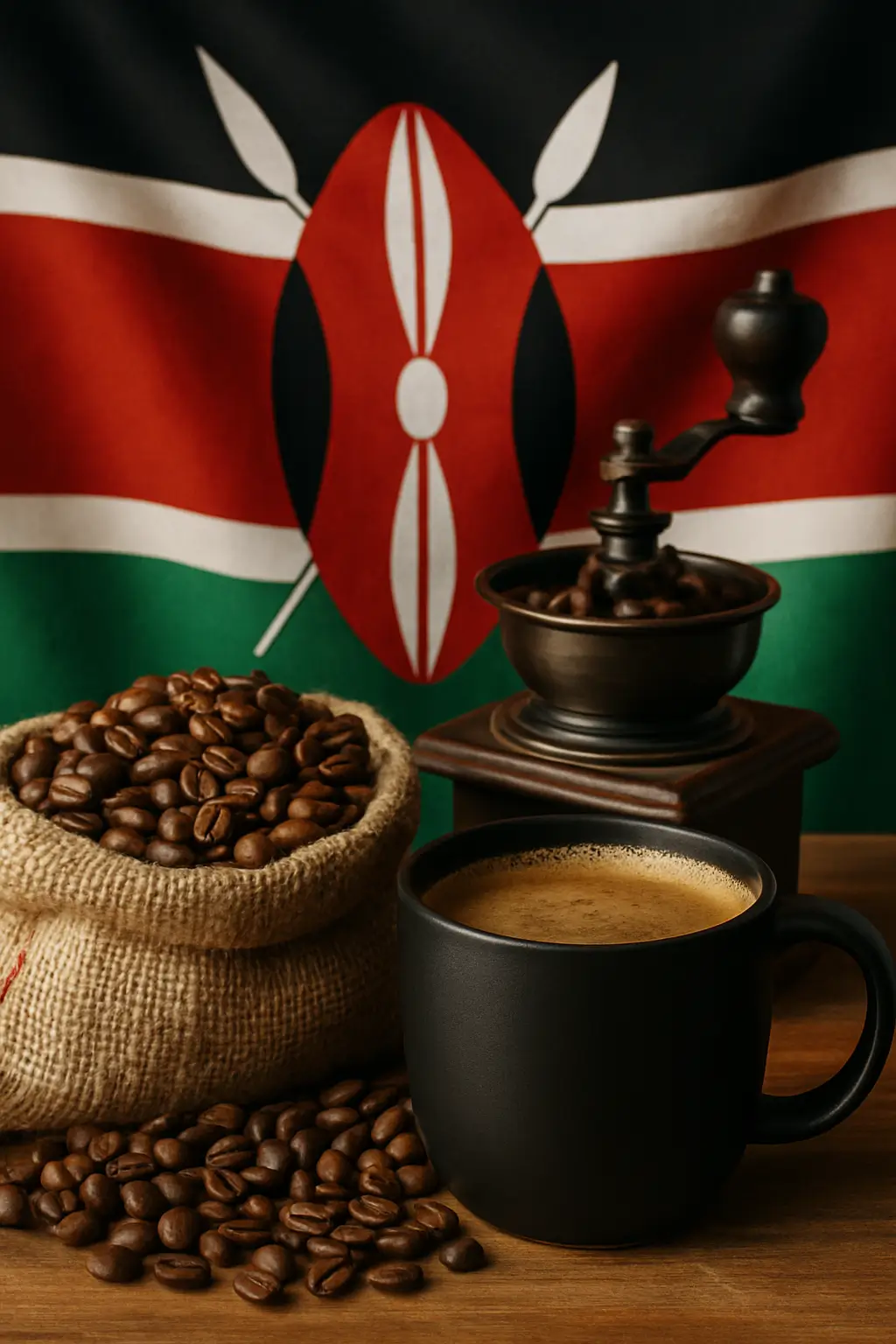People around the world love Kenyan coffee. It stands out for its great quality. It comes from East Africa. You’ll notice its bright acidity, medium to full body, and complex flavors. This guide shows why Kenyan coffee is so special. We’ll look at its taste, how it grows, how farmers process it, and its long history.
- What is the distinctive flavor profile of Kenyan coffee?
- Where does Kenyan coffee thrive?
- How are Kenyan coffee processing methods mastered?
- How is quality understood through the Kenyan coffee grading system?
- How does Kenyan coffee compare on the global stage?
- What is the rich heritage and history of Kenyan coffee?
- What makes Kenyan coffee so special?
What is the distinctive flavor profile of Kenyan coffee?
Kenyan coffee has a unique taste. It’s known for its bright acidity and medium to full body. You’ll find many complex flavors and aromas. This coffee often tastes vibrant, crisp, even effervescent. That sets it apart from many other coffees.
Its unique taste includes prominent fruity, floral, and sweet characteristics that evolve in the cup. Common flavor and aroma notes include:
- Berry Flavor: Often reminiscent of blackcurrant, offering a deep, tart sweetness.
- Citrus Flavor: Notes like grapefruit and tangerine provide a zesty, refreshing quality.
- Stone Fruit Flavor: Hints of peach or apricot add a delicate, juicy sweetness.
- Wine-like Quality: A characteristic richness and dryness that lingers on the palate.
- Floral Aromas: Scents of jasmine, rose, hibiscus, or wildflowers contribute to its perfumed complexity.
- Herbal Undertones: Subtle notes like tea or sage add an earthy balance.
- Natural Sweetness: Hints of honey, caramel, or brown sugar often complement the coffee’s tartness.
- Fresh Tomato Note: Some cups surprisingly reveal a savory undertone, adding an intriguing depth to the overall profile.
This mix makes Kenyan coffee a dynamic, layered experience. People who want a vibrant, nuanced cup truly appreciate it.
Where does Kenyan coffee thrive?
Kenyan coffee grows best in high-altitude areas. Specific geography and climate help it develop unique characteristics. East Africa’s position creates an ideal place for high-quality Arabica.
Key growing conditions include:
- High Altitude: Coffee plants typically grow between 1,500 and 2,100 meters above sea level, particularly around Mount Kenya and the Aberdare Range. This elevation promotes slow cherry maturation, allowing complex flavors to develop intensely within the bean.
- Volcanic Soils: The fertile, nutrient-rich volcanic soils, especially prevalent in Central Kenya, significantly enhance the coffee’s flavor development and contribute to its renowned acidity.
- Ideal Climate: Moderate temperatures, generally between 15°C and 24°C, coupled with annual rainfall ranging from 1,100–1,500 mm, support healthy coffee growth and consistent cherry development.
Farmers mostly grow Arabica varieties like SL28, SL34, Batian, Bourbon, K7, and Ruiru 11. These types were chosen or bred to grow well in Kenya, producing high-quality beans.
Which are Central Kenya’s coffee belt regions?
Central Kenya’s Coffee Belt holds the main growing counties. Each helps produce high-quality coffee for the nation. These include Nyeri, Kirinyaga, Kiambu, Murang’a, Embu, and Thika. They all sit near Mount Kenya and the Aberdare Range.
Nyeri is known for its high altitude – 1,600 to 2,000 meters. Its volcanic soil is very fertile. This gives the coffee bright acidity, a medium body, and distinct fruity, caramel notes. Kirinyaga has an average temperature of 20°C. It gets 1,100–1,500 mm of rain. Often, it has two harvest seasons, ensuring a steady supply of good Arabica beans. Many smallholder farmers here work in cooperatives. Kiambu, Murang’a, Embu, and Thika have similar good altitudes and climates. They consistently produce coffee with complex floral and fruity tastes. These Central Kenya regions show the perfect growing conditions for top-tier Kenyan coffee.
What other notable cultivation areas exist for Kenyan coffee?
Other areas also grow Kenyan coffee. Look beyond the central belt to Western Kenya and the Rift Valley. They aren’t as well-known, but they still add to Kenya’s diverse coffee output.
Western Kenya, including Bungoma and Kakamega, grows both Arabica and Robusta. This can lead to more robust, unique blends. The Rift Valley, with counties like Kericho, Bomet, and Nakuru, has rich volcanic soils and good altitudes. Coffee from here often has a more robust, full-bodied taste. This shows how versatile Kenya’s coffee growing is. These regions prove Kenya can produce varied coffee styles. But the classic Kenyan taste mostly comes from the central highlands.
How are Kenyan coffee processing methods mastered?
Kenyan coffee uses wet processing. This method is key to getting its clean, bright, fruity taste. It involves several careful steps after picking ripe coffee cherries.
Farmers handpick the cherries. Then, they pulp them to remove the outer skin. This leaves the beans covered in mucilage. Beans ferment in water tanks for 12 to 48 hours. Natural enzymes break down the mucilage. After fermentation, thorough washing removes any remaining mucilage. Farmers then dry the beans carefully on raised beds in the sun. One special method is the “Triple Ferment Process,” or “72-hour process.” It uses three separate fermentation stages with washes in between. This refines the flavor more and removes impurities. The result is intense sweetness and clarity.
Wet processing is standard, but some use variations. Dry fermentation, for example, ferments beans in tanks without water. This breaks down mucilage slowly and allows deeper sugar absorption. You might get sweeter, more complex flavors. Extended or double fermentation adds a second phase after an initial wash. This really boosts flavor complexity, sweetness, and bright acidity. These methods are crucial for Kenyan coffee’s high quality and distinct taste.
How is quality understood through the Kenyan coffee grading system?
Kenya’s coffee grading system defines quality. It sorts beans by size, shape, density, color, and defects. This strict system directly affects market value and quality perception. It ensures consistency for buyers.
The official grading system categorizes coffee beans into eight main grades:
- Kenya AA: This is the highest and most prized grade, comprising large, dense beans measuring over 7.2 mm (size 18). Kenya AA coffee is globally recognized among the finest, offering exceptional bright acidity, a wine-like fruitiness, and delicate floral aromas.
- Kenya AB: Slightly smaller than AA, these beans measure approximately 6.8 mm (sizes 16-17). Kenya AB combines A and B beans and constitutes about 40% of Kenya’s coffee crop. It still delivers a bright, fruity profile but is generally less valued than the premier AA grade.
- Kenya PB (Peaberry): These are distinct, round beans resulting from a natural mutation where only one seed develops inside the coffee cherry instead of two flat-sided beans. Peaberry coffee is highly sought after for its concentrated and unique flavor profile.
- Kenya E (Elephant Bean): Representing the largest flat beans in terms of size, Kenya E beans are nonetheless often considered of lower overall quality despite their impressive dimension.
- Other Grades: Additional grades like Kenya C, TT, T, and MH/ML represent progressively smaller bean sizes or specific characteristics, resulting in lower quality and market value compared to the top grades.
Besides bean size, Kenyan coffees get a Quality Class score from 1 to 10. This score judges the actual cup quality. It also affects the coffee’s market value. The whole grading system creates uniform commercial lots. This helps fair pricing at the weekly Nairobi Coffee Exchange auctions. These auctions are the main sales platform for Kenyan coffee.
How does Kenyan coffee compare on the global stage?
Kenyan coffee is a top single-origin coffee worldwide. It’s known for its bright, wine-like acidity, rich full body, and complex fruit and berry flavors. Its unique taste makes it stand out, especially against other good East African coffees.
Kenyan coffee has sharper, stronger acidity than Ethiopian coffee. It also has a distinct winey richness and a dry aftertaste. Ethiopian coffee is known for its delicate, lighter body. It has intricate floral and fruity complexity, often with blueberry and jasmine notes. Both are excellent, but Ethiopian tastes are often more subtle and perfumed. Tanzanian coffee shares some berry notes and balanced sweetness with Kenyan. But it’s usually milder and less acidic.
Kenyan coffee’s consistent quality comes from its careful grading system and common wet processing. Wet processing boosts its clear, bright acidity. High growing altitudes, usually 1,700–1,800 meters, and unique volcanic soils also help. They create nutrient-rich beans with great flavor. Kenyan coffee has bold acidity, a full body, complex fruit tones, and a winey character. That makes it a top choice for coffee lovers who want a vibrant, intense cup.
What is the rich heritage and history of Kenyan coffee?
Kenyan coffee has a long history. European missionaries brought Arabica coffee here in the late 1800s. The first Arabica trees, Bourbon variety, were planted around 1893 in Bura, Taita Hills, and Kibwezi by 1900.
Coffee farming grew a lot in the early 1900s. British colonial rule pushed it as a key economic resource. Large plantations started, mostly run by European settlers. Local workers often faced tough conditions. New roads and railways also made it easier to move coffee from farms to cities and export points.
Coffee cooperatives were a huge step. The first ones formed as early as 1908. They helped smallholder farmers by letting them share resources and knowledge. This built the strong cooperative system Kenya has today. By the 1990s, Kenya was a major global coffee producer. It put out about 72,000–78,000 metric tons each year. Coffee was the third-biggest earner of foreign money. It supported over 700,000 smallholder farmers in cooperatives. Even with recent drops in production and market pressure, Kenyan coffee shows great resilience. It’s still very important for its farmers and cooperatives.
| Category | Description |
|---|---|
| Origin | East Africa, primarily high-altitude regions. |
| Flavor Profile | Bright acidity, medium to full body, complex fruit (blackcurrant, citrus, stone fruit), floral, wine-like, herbal, natural sweetness. |
| Growing Regions | Central Kenya (Nyeri, Kirinyaga, Kiambu, Murang’a, Embu, Thika) and parts of Western Kenya, Rift Valley. |
| Altitude | 1,500 – 2,100 meters above sea level. |
| Soil Type | Fertile, nutrient-rich volcanic soils. |
| Processing | Predominantly wet (washed) processing, including “Triple Ferment” and extended fermentation methods. |
| Grading System | Stringent system based on bean size (e.g., AA, AB, PB) and Quality Class score. |
| Key Varietals | SL28, SL34, Batian, Bourbon, K7, Ruiru 11. |
What makes Kenyan coffee so special?
Kenyan coffee is special because of three things: ideal growing conditions, a unique taste, and careful processing and grading. Its bright acidity and complex flavors—like blackcurrant, citrus, and wine—come from high altitudes and rich volcanic soils in places like Nyeri and Kirinyaga. Farmers widely use wet processing, even advanced fermentation, for a clean, vibrant, flavorful cup.
This focus on quality, from farm to cup, makes Kenyan coffee a top choice globally. It gives you a tasting experience like no other. You’ll find complexity and vibrancy every time. Try our premium Kenyan coffees today. Experience that vibrant taste for yourself!









